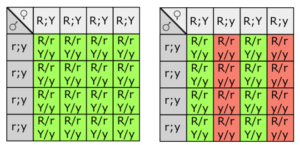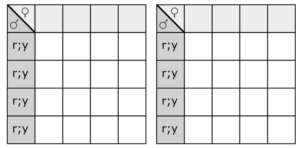2.5 The Dihybrid Test Cross
While the cross of an F1 x F1 gives a ratio of 9:3:3:1, there is a better, easier cross to test for independent assortment: the dihybrid test cross. In a dihybrid test cross, independent assortment is seen as a ratio of 1:1:1:1, which is easier to score than the 9:3:3:1 ratio. This test cross will also be easier to use when testing for linkage.
Like in monohybrid crosses (Chapter 1), you can do test crosses with dihybrids to determine the genotype of an individual with dominant phenotypes, to see if they are heterozygous or homozygous dominant. This type of cross is set up in the same fashion; an individual with an unknown genotype in two loci is crossed to an individual that is homozygous recessive for both loci.

Take a look at the video, Two-Gene Test Cross Explained, by Nicole Lantz (2020) on YouTube, for some worked examples.
Punnett squares should be done ahead of the crosses, so you know what to expect for any of the possible outcomes. Using the example from the rest of this chapter, you cross a double homozygous recessive pea plant (r/r ; y/y. green and wrinkled) to an unknown individual that has two dominant phenotypes (R/_ ; Y/_. yellow and round). There are four possible genotypes the unknown individual could be: R/R ; Y/Y or R/R ; Y/y or R/r ; Y/Y or R/r; Y/y. The Punnett squares for the first two are shown in Figure 2.5.1. Notice on the left, you only get the dominant phenotype for both, so you know both genes in the unknown are homozygous dominant. On the right, you get only the dominant phenotype for round peas — but you get 50% yellow and 50% green peas, showing that the unknown is homozygous for round, but heterozygous for colour of the peas. Figure 2.5.2 is blank for you to fill in the other two gamete and genotype possibilities.

Media Attributions
- Figure 2.5.1, Original by L.Canham (2017), CC BY-NC 3.0
- Figure 2.5.2, Original by L.Canham (2017), CC BY-NC 3.0
References
Canham, L. (2017). Figures: 7. Punnett square for a test cross; 8. Blank Punnett squares to fill in the other two possibilities of the test cross [digital images]. In Locke, J., Harrington, M., Canham, L. and Min Ku Kang (Eds.), Open Genetics Lectures, Fall 2017 (Chapter 17, p. 6-7). Dataverse/ BCcampus. http://solr.bccampus.ca:8001/bcc/file/7a7b00f9-fb56-4c49-81a9-cfa3ad80e6d8/1/OpenGeneticsLectures_Fall2017.pdf
Nicole Lantz. (2020, May 5). Two-gene test cross explained [Video file]. YouTube. https://youtu.be/GM0by2axiLM
Long Descriptions
- Figure 2.5.1 Two Punnett squares: The first is a testcross between a dihybrid homozygous dominant organism (RRYY) and the tester, which is a dihybrid homozygous recessive organism (rryy). The offspring and their genotypes in this test cross are shown, with all possessing the heterozygous condition for both traits (RrYy). The second is a testcross between a dihybrid heterozygous organism (RrYy) and the tester, which is a dihybrid homozygous recessive organism (rryy). The offspring and their genotypes in this test cross are shown, with half possessing the heterozygous condition for both traits (RrYy) and the other half expressing the genotype Rryy. [Back to Figure 2.5.1]
- Figure 2.5.2 A blank Punnett square can be used for practice, and to fill in the other two gamete and genotype possibilities for the question in the text directly preceding this figure. [Back to Figure 2.5.2]

